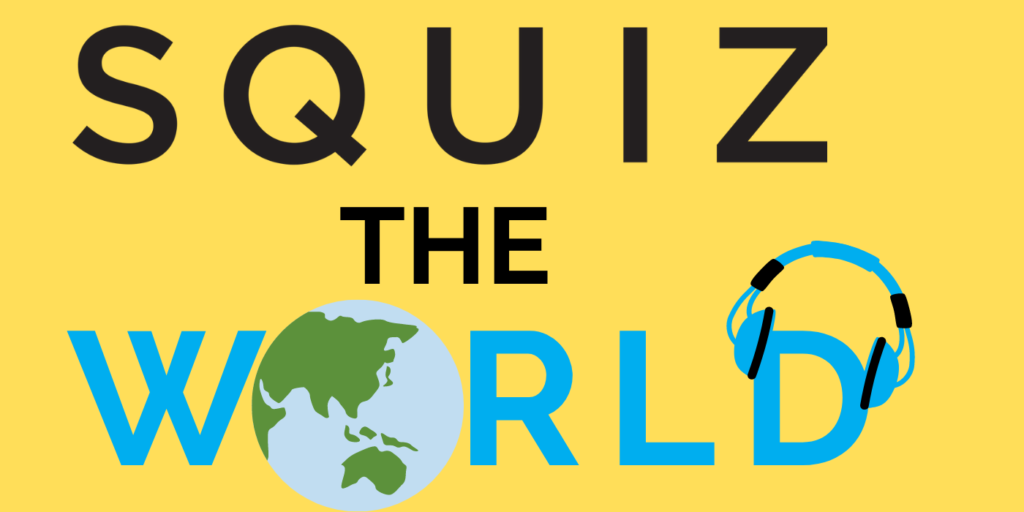
Squiz the World goes to… Jamaica
LINKS:
Visit Saint Ann: https://au.trip.com/travel-guide/saint-ann-1699894/tourist-attractions-photo/
Jamaican Patois translator: https://www.jamaicantranslator.com/
Do the Reggay by Toots and the Maytals: https://youtu.be/bGkpDM4M7P4
Could You Be Loved by Bob Marley: https://www.youtube.com/watch?v=1ti2YCFgCoI
Don’t Look Back (live) by Peter Tosh: https://youtu.be/enIfdOl83Pw
Marcia Griffiths live in concert, 2019 (aged 70): https://www.youtube.com/watch?v=qsr4b7vX8rU
EPISODE TRANSCRIPT
Each week, we give the world globe a spin, and see where we land. Then we take the kids of Australia on an audio excursion to visit that country and its people.
I’m Amanda Bower, and today on Squiz the World we are packing our sunscreen, putting on our dancing shoes, and heading to the home of reggae. Can you guess where we’re going? Quick! Strap yourselves into the Squiz Kids Super Fast Supersonic Jetliner so we can take off and have a party in Jamaica.
JUST THE FACTS
Jamaica is the third biggest island in the Caribbean, after Cuba and Hispaniola. Now, your parents and teachers might say to you, “There’s no such country as Hispaniola!” And they’re clever people, those grown ups. It’s true! Hispaniola is an island with two countries on it: Haiti and the Dominican Republic.
Back to Jamaica. It’s known for its gorgeous beaches, but it actually sits on top of a huge underwater mountain, and if you take a moment to leave the beach, you’ll find that Jamaica has four separate mountain ranges! Still, one third of the country’s almost 3 million people live in the capital, Kingston, which is on the coast. It’s a bit like Australia, in that respect… think about where most of our population lives.
Also like us, Jamaica was once a colony of Britain. They got their independence in 1962, but like us, they have a governor-general and are still part of the Commonwealth. Their political system is also set up like ours, with two houses of Parliament.
Unlike us, Jamaica was a colony of Spain before the British took over—and because of that, it became riddled with pirates!
Bear with me.. in the 1600s, the Spanish made several attempts to re-capture the island, so the British had the bright idea to support any pirates who were attacking Spanish ships in the Caribbean.
The Jamaican town of Port Royal became infamous – that means famous for a bad reason – for being full of pirates and a complete disregard of the law. Eventually the Spanish promised to stay away from Jamaica, and the British worked on reining in the pirates – but even today, you can do all sorts of pirate tours in Port Royal, including exploring a sunken pirate city!
Whenever you travel, it’s important to learn a few words in that country’s language. It’s a great way to show respect. So, let’s….
LEARN THE LINGO
In Jamaica the official language is English. But locals also speak something called Jamaican Patois, which is a combination of English, the West African Akan language, and other influences.
We are so extremely privileged to have with us here today Squiz Kid Danielle, all the way from Jamaica, to teach us some Patois! Take it away, Danielle…
Hi, my name is Danielle and I live in Jamaica in a place called St. Ann. I learn in English, but at home, I also speak the Jamaican dialect, called patois. Here’s how you say these words in patois.
“Hello, how are you?
Patois – hey, wha gwaan?
“Where do you come from?”
Patois – A whey yuh cum fram?
“And what grade are you in at school?”
Patois – A wha grade yuh inna a school?
Thank you so much, Danielle. I’ve put a link in your episode notes to St Ann, so you can see the kind of paradise Danielle lives in. And for those of you interested in learning more patois, I’ve popped a link to a Jamaican translator web page in the episode notes.
Now that we can communicate a little bit, it’s….
TIME FOR SCHOOL
If you go to school in Jamaica, you’d better be prepared to work hard. According to my research, kids start getting homework in Year One, and by the time they’re your age, they have at least two hours a night, and up to EIGHT hours on the weekend! And if you don’t do your homework, you’d better expect a call home to your parents.
Yikes.
The reason for all this stress is that in Year 6, every kid in Jamaica sits five important exams: Maths, Social Studies, Science, Writing, and Language Arts – which is spelling, reading comprehension, and grammar.
The high school you go to depends on the score you get on those exams – kind of like how the uni course you do in Australia depends on your year 12 results. Which is stressful enough in year 12, but year 6? Wow.
The funny thing is, it’s hard to imagine people being super stressed out in Jamaica, because it has such a reputation for being laid back and relaxed. A big part of that reputation comes from a type of music that started in Jamaica in the 1960s, and has since spread all over the world. I think we should get our groove on.. So…
LET’S GET CULTURAL
Hands up if you’ve heard of reggae. How about Bob Marley? Thought so.
Reggae is now played all over the world, but it started in Jamaica in the 1960s. It was, and is, a way for Jamaicans to tell the world about their history, culture, struggles, and for many reggae artists, their religion – the musical style is strongly associated with Rastafarianism, a religion that became very strong in Jamaica starting in the 1930s.
So, let’s write our own reggae song. We’re going to start first with the rhythm, which is probably the biggest thing that makes reggae, reggae. Most songs are written in four/four – you may have learned about that in music – but instead of emphasising those four beats, reggae puts the emphasis on the beats in between… 1-and-2-and-3-and-4. That rhythm comes from guitar, which in reggae is called “skank” guitar. The guitar plays short, sharp chords, just on the “ands”. Have a listen here.
(audio)
Okay, now we’ve got our skank guitar beat. Let’s add some drums. To make them reggae drums, we’ll make sure they play on the “2, 3, 4” of that 4/4 timing, but not on the 1. Let’s listen to that by itself, and then layer it over the skank guitar.
(audio)
Now we’re starting to groove. Reggae is very bass-heavy, so let’s add in some bass. If we play just the bass line, we won’t necessarily recognise it as reggae, because finally there’s one musician allowed to play on the “1”! Have a listen to it alone, then we’ll add it to the drums and guitar.
(audio)
And voila, we have the backbone of a reggae song. Now, you can add other instruments, and of course your vocals and harmonies. I’m pretty sure you don’t want to hear me singing in a fake Jamaican accent, and that DEFINITELY wouldn’t be appropriate anyway…
So in your episode notes, I’ve put links to songs by Bob Marley, Peter Tosh, Marcia Griffiths, and … this one’s important… the song “Do the Reggay” by Toots and the Maytals. That’s the song that gave this entire music genre it’s name. Do yourself a favour before you listen… push back your chair, kick off your shoes, and get ready to dance! Marcia Griffiths is 72 years old and she’s STILL singing and dancing, so what’s your excuse???
Phew! I’m exhausted. I always feel a bit peckish after a boogie. I think it might be…
DINNER TIME
The national dish of Jamaica is called ackee and salt fish, and it can be eaten for breakfast, lunch, or dinner! Ackee is the national fruit of Jamaica – it came to the Caribbean from West Africa more than 300 years ago. In the Twi language of Ghana, the fruit is called Ankye, which is how we got to Ackee.
Now ackee is pretty amazing. It looks a bit like a red pear, but it’s poisonous unless it’s cooked properly. Once cooked properly, it’s a delicacy! You can buy it canned, so that someone else has done the safe cooking for you… that’s how I recommend it!
This famous dish is all made in one pot – I love less washing up – and combines salted fish with ackee, capsicum, onions, a tomato, and herbs. Easy AND delicious! I’ll put the recipe in your episode notes.
THE S’QUIZ
This is the part of the podcast where you get to test how well you’ve been listening.
Question 1. Britain supported pirates attacking ships from which country?
Question 2. What is the national fruit of Jamaica?
Question 3. How do you describe the guitar that gives reggae its rhythm?
